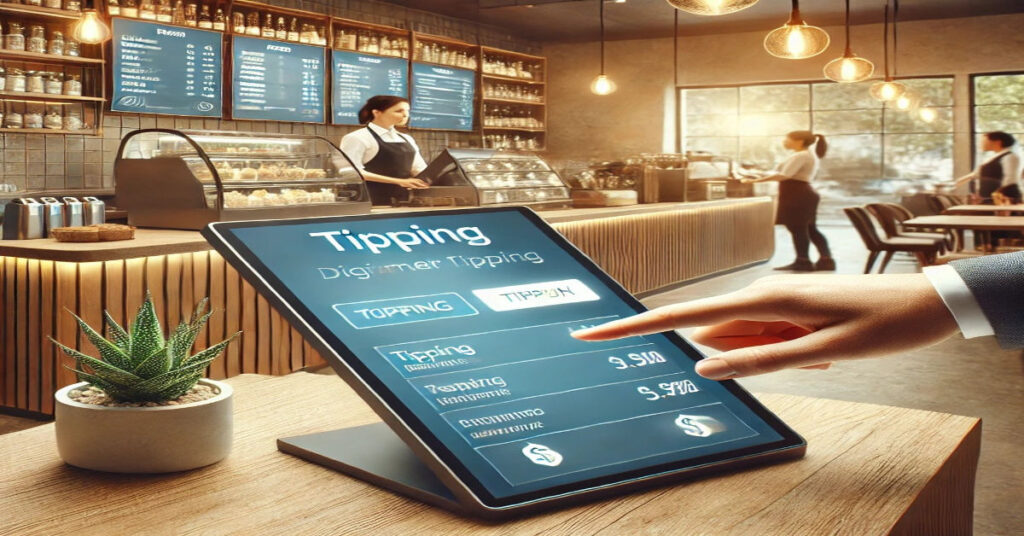With the rapid integration of digital checkout systems tipping screens have become a ubiquitous part of many transactions at cafes, restaurants, and service-oriented businesses. What once was a voluntary expression of gratitude is now embedded in digital workflows, often leaving customers feeling pressured and confused. As businesses navigate the opportunities and risks of these digital prompts, it’s essential to understand their impact on customer experience and business success. In this article, we’ll dive into the concept of the tipping screen, its pros and cons, consumer reactions, and best practices for businesses using this technology.
What Is a Tipping Screen?
A tipping screen is a feature integrated into digital point-of-sale (POS) systems or checkout tablets, prompting customers to leave a tip during the payment process. Found in coffee shops, food trucks, restaurants, and even non-traditional tipping industries like salons and retail stores, these screens typically offer preset tipping options ranging from 10% to 25% of the total bill.
- How It Works: When a customer completes their order and reaches the checkout, the tablet or screen presents them with multiple tipping options before finalizing the payment.
- Preset Options: Many tipping screens come preloaded with suggestions, but customers can often enter a custom tip or choose not to tip at all.
The tipping screen was designed to streamline gratuity decisions while offering businesses a means to boost employee earnings. But this system has come under scrutiny due to the rise of “tip fatigue” among consumers.
The Emergence of Tip Fatigue: What It Means for Customers
Tip fatigue refers to the exhaustion, confusion, or frustration consumers feel when faced with frequent tipping requests, often through digital checkout systems. According to recent research, many customers report feeling manipulated or coerced into leaving tips, even in situations where tipping was not traditionally expected.
Reasons for Tip Fatigue:
- Frequent Tipping Requests: Tipping screens are being implemented in places where gratuity wasn’t typically required, such as fast food chains and retail stores.
- Preset High Tip Options: Some screens suggest high tips (20%–30%) as default options, which consumers find excessive.
- Guilt-Driven Choices: The presence of service staff and others in line may pressure customers to tip out of guilt or social obligation.
Impact on Consumers:
- Over 70% of surveyed consumers say they encounter tipping screens too often.
- Many feel frustrated or confused, especially when unclear if tipping is genuinely expected or simply a suggestion.
Benefits of Tipping Screens for Businesses
Despite the consumer backlash, tipping screens do offer advantages that businesses can leverage to enhance employee satisfaction and improve overall service.
1. Increased Employee Earnings
One of the primary benefits of tipping screens is that they often lead to higher tips compared to cash-based or traditional tipping methods. With suggested options conveniently displayed, customers are more likely to select a tip that boosts workers’ incomes.
- Impact on Employee Morale: Higher tips may lead to greater job satisfaction and motivation, especially in industries reliant on gratuities.
2. Convenience for Customers
For many customers, tipping via digital prompts is easier than manually deciding how much to leave or calculating percentages. The quick, one-tap option helps simplify the checkout process.
3. Encouraging Generosity
Research shows that preselected tip suggestions subtly influence consumer behavior. For example, when customers see options for 15%, 20%, or 25%, they are likely to choose one of those rather than opting for no tip.
4. Enhanced Efficiency
For businesses, tipping screens help speed up transactions. Without the need to handle cash or split tips manually, employees can focus on providing better service.
Challenges and Drawbacks of Tipping Screens
Despite the convenience and benefits, tipping screens come with challenges that businesses must consider. Failure to address these drawbacks could lead to customer dissatisfaction and reduced loyalty.
1. Customer Discomfort
Customers often report discomfort when prompted to tip in situations they deem unnecessary. For instance, being asked to leave a tip at self-service kiosks or drive-throughs can feel excessive.
2. Damage to Brand Reputation
If customers perceive tipping prompts as manipulative or money-driven, businesses risk damaging their reputations. Negative experiences shared online could lead to poor reviews and a drop in customer retention.
3. Tip Fatigue and Decreased Generosity
Repeated exposure to tipping screens may lead customers to tip less frequently or even refuse to tip altogether, undermining the system’s initial goal of boosting gratuities.
4. Lack of Clarity
In some cases, tipping prompts lack clarity about where the tips go—whether to individual employees, a pooled system, or the business itself. This lack of transparency can result in distrust.
How Businesses Can Avoid Tip Fatigue and Improve Customer Experience
To mitigate the risks of tip fatigue and ensure tipping screens are a positive aspect of the customer experience, businesses should adopt thoughtful strategies.
1. Use Reasonable Preset Options
Preset tipping amounts should be reasonable and reflective of the service provided. Instead of offering options like 20%, 25%, and 30%, businesses can include lower percentages (e.g., 10%, 15%, 20%) to cater to a broader customer base.
2. Provide Customizable Options
Allowing customers to choose a custom tip or opt out without feeling pressured is essential. Clear and easy-to-find “No Tip” or “Custom Amount” buttons can alleviate frustration.
3. Be Transparent About Tip Allocation
Inform customers about how tips are distributed. Whether tips go to individual servers, a team, or the business, transparency helps build trust.
4. Avoid Overusing Tipping Prompts
Not every transaction warrants a tipping request. Businesses should evaluate where and when it’s appropriate to display tipping screens, focusing on situations where personalized service has been delivered.
5. Train Staff on Handling Tipping Interactions
Staff should be trained to handle tipping-related interactions gracefully. Employees should never pressure or guilt customers into tipping, as this can damage the relationship between the business and its clientele.
6. Collect Feedback Regularly
Gathering customer feedback on tipping experiences can help businesses adjust their practices. Understanding what works and what doesn’t allows for improvements that align with customer expectations.
The Future of Digital Tipping: What to Expect
As technology continues to evolve, tipping screens will likely become even more widespread, but with added innovations and improvements.
AI-Driven Tipping Recommendations
Future tipping screens may use AI to personalize suggestions based on customer behavior, purchase history, and past tipping patterns. For example, a frequent customer who previously tipped 15% may see that amount as a default option.
Integrating Loyalty Programs
Some businesses may link tipping screens with loyalty programs, offering rewards or discounts based on tipping behavior. This could incentivize customers while reducing resentment over frequent tipping requests.
Voice-Activated Tipping
With the rise of voice technology, tipping could become more interactive, allowing customers to dictate tip amounts verbally through smart devices or kiosks.
Tipping Screens Beyond the Hospitality Industry
While tipping screens are most common in cafes and restaurants, other industries have started adopting them to enhance customer engagement and employee compensation.
- Ride-Sharing Services: Many platforms already use digital tipping, but on-screen prompts in physical locations like airports could become common.
- Retail Stores: Although traditionally not associated with tipping, certain boutique stores and service-oriented retail outlets have started experimenting with tipping screens to boost employee pay.
- Healthcare and Wellness: Gyms, spas, and wellness centers are increasingly using tipping screens to recognize excellent customer service.
Conclusion
The tipping screen has undoubtedly transformed the way gratuities are handled, providing both opportunities and challenges for businesses. While they can help boost employee earnings and streamline transactions, overusing them or setting unrealistic expectations can lead to customer dissatisfaction.
The key for businesses is to strike the right balance—using tipping screens thoughtfully and transparently while respecting customer preferences. By implementing best practices and adapting to customer feedback, businesses can ensure that tipping screens enhance, rather than hinder, the overall experience.
FAQs
1. What is a tipping screen, and where is it used?
A tipping screen is a feature on digital payment systems that prompts customers to leave a gratuity. It’s commonly used in restaurants, cafes, salons, and other service industries.
2. What is tip fatigue, and how does it affect customers?
Tip fatigue occurs when customers feel overwhelmed or frustrated by frequent tipping requests, leading to dissatisfaction or reduced tipping.
3. How can businesses avoid tip fatigue?
Businesses can prevent tip fatigue by using reasonable preset tip options, allowing custom tips, and only prompting for tips when appropriate.
4. Do tipping screens increase employee earnings?
Yes, studies show that tipping screens often lead to higher gratuities compared to manual tipping methods, benefiting employees.
5. Are tipping screens appropriate for all businesses?
No, tipping screens should be used in industries where personalized service is provided. Using them in settings like retail may backfire.
6. What role does transparency play in tipping practices?
Transparency about how tips are distributed builds customer trust and increases the likelihood of positive tipping experiences.







